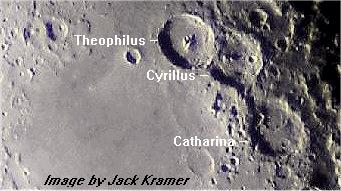5-Day Old Moon: Theophilus, Cyrillus and Catharina
Paul Morow
Along the western shore of Mare Nectaris three magnificent craters can be found. Theophilus, Cyrillus and Catharina lay side by side giving an observer three examples of craters of vastly different ages. Each crater has it's own individual characteristics which makes it distinctly different from the others.
Theophilus, the northernmost of the trio, is obviously the youngest with its massive walls rising about 3.5 miles above the interior. These huge walls appear as two to three concentric ring mountain ranges, each successively lower to the next until the floor is reached. At lower magnifications Theophilus appears to be circular while higher powers show the walls to be composed of linear segments. Along the northern wall Theophilus B appears as a round crater imbedded between two of the huge terraced walls. Theophilus also contains magnificent multiple central mountains with one of the peaks rising about 6000 feet above the floor. Fred Price, author of The Moon Observer's Handbook writes, "A curious thing about the central mountain is that its contour seems to change as the lunation progresses. W.H. Pickering considered these appearances to be due to deposit, and later melting, of snow!" We now know that Pickering's theories do not represent the sequence of changes as observed, but they do make for good story telling. These highly developed terraces and central peak systems of the well-preserved crater Theophilus are worth further study during good illumination.

The walls of Theophilus encroach upon its southerly neighbor Cyrillus, which appears older and less preserved. In addition to Cyrillus showing a lack of sharpness, it is obvious that the Theophilus impact destroyed a section of it's walls. This older crater has been modified by age and shows fine detail within its slumping walls. The southwestern wall contains a bowl shaped crater, Cyrillus A, that appears larger than Theophilus B. The floor of Cyrillus does not appear smooth like the floor of Theophilus, but rough with depresses. There is a triple mountain in the center of Cyrillus that shows good detail during good illumination. South from the central peaks there is a curving rile that can be detected while using higher magnifications. After these observations one can conclude that Cyrillus is considerably older than Theophilus.
Moving south from the crater Cyrillus we find our third member Catharina, which are connected by a large broad valley. Catharina is the largest of the three craters and appears severely battered. One look will convince you that this is the oldest of our trio. Catharina has been nearly obliterated by several impacts, the largest Catharina P, appears as a ghost ravaged by time. The northeastern wall contains craters Catharina B and G that have taken their toll on the ancient rim. Within the far southern wall Catharina S appears to be one of the younger impacts due to its well-defined rim. There is no sign of central peaks within the floor of Catharina, but they must have existed years ago but now are not detectable. The floor of Catharina appears smoother than that of Cyrillus. This is most likely due to the features becoming buried from the debris of the near by impacts through the ages. This concludes my journey through the pulverized landscapes of Theophilus, Cyrillus and Catharina ... until the next lunation.
Equipment: 155mm f/9 refractor
Reference: Atlas Of The Moon, By Antonin Rukl (Maps 46 & 57)
Published in the June 2003 issue of the NightTimes




